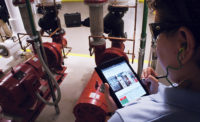
Some companies may view lockout-tagout as a nuisance. They grit their teeth and comply. But when they find out that lockout-tagout compliance can save money, they usually have much less objection.
In my experience, companies that implement graphical lockout-tagout procedures achieve at least a 40-percent increase in efficiency. A lockout that used to take 20 minutes now takes 12 or less. So what does this mean for the bottom line? With each lockout taking 40 percent less time, you can translate that into more uptime. More uptime equals a more efficient facility, which means more profit.
How to start
If you decide to upgrade to a graphical system, where do you start? If your current program hasn’t been audited for three-plus years (remember OSHA requires that you audit annually), chances are it will be faster for you to start from scratch rather than try to extract the data, then verify it is correct.
Let’s assume you’re starting from scratch. The first step is to conduct an equipment count. Walk through your facility and identify every piece of equipment that requires a procedure. OSHA requires a piece of machinery to meet all of the following eight criteria in order to be exempt:
- Have no potential for stored or residual energy;
- Have one energy disconnect that can be easily isolated;
- Be completely isolated and deactivated by that one disconnect;
- Be able to be locked out during service or maintenance;
- Be able to be locked out using only one device;
- Have the device under exclusive control of the employee for the duration of servicing;
- Be able to be serviced without creating hazards for other employees;
- Have no prior accidents due to uncontrolled energy.
Creating procedures
Once you have your list, prioritize it with the most complex and most often locked out equipment at the top, and the least complicated and least locked out equipment at the bottom. When you are ready to assess your first piece of equipment, take with you a notebook, pen and a digital camera with a steady shot feature so you don’t need a tripod. Document which pictures go with each machine, and which side of the machine was photographed. Each picture will contain isolation points, which need to be recorded in your notes.
Begin slowly by assessing one or two machines, then return to your office to create the procedures with your notes and pictures. Procedures should include all equipment identification information in the header, such as: model, serial, equipment number, asset number, description, building name, area, etc. Then insert your pictures below the header and use Office 2007 - Microsoft Excel software’s object function to point out the isolation points in the pictures. Some familiarity with Excel’s functionality will help at this point, but if you are struggling, the help menu is very well written and will answer most of your basic questions in seconds.
After you’ve placed, sized and cropped your pictures to your liking, move down below them and put the information you documented about the isolation points in an easy-to-read bar/column format. Identify energy source type, magnitude, device necessary, location, method to isolate and, most important, how to verify you’ve properly isolated that disconnect (i.e. attempt to restart, verify gauge pressure is zero, etc.).
After you’ve finished your procedure, print it off and check it over again on the floor. If you are unsure, have an operator run through a test to ensure that the procedure you created will in fact bring the machine down to a zero energy state and it will not restart. Make sure you add OSHA’s typical minimum lockout-tagout procedures as a shutdown and start-up sequence on the back. This will ensure an added level of safety and compliance.
In-house or out?
Now you’ll be on your way to building a graphical program that operators will be more encouraged to properly utilize when servicing their equipment. If you’re unsure of whether or not to outsource this new procedure creation, attempt it in-house to give you a good feel of the value you are receiving, should you decide to outsource it at a later date. It will also give you a better grasp of what to ask for, how you want your procedures to look, and unique characteristics of the equipment that you want incorporated.
OSHA’s lockout-tagout regulation was written before the advent of digital cameras or the personal computer for that matter. Right now, it’s completely up to the employer if they want to exceed OSHA’s 27-year-old lockout-tagout regulation.

